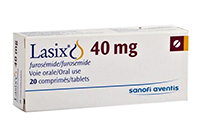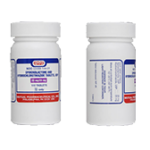
Lasix

What is Lasix?
Lasix is an oral drug indicated in all forms of edema of cardiac genesis, inadequate edema control (of renal or non-renal origin), corticosteroid refractory edema, light and medium hypertension.
Lasix in solution for infusion and in tablets of 500 mg is indicated only in cases of acute or chronic kidney failure, as well as in individuals with nephrotic syndrome (chronic glomerulonephritis, lupus erythematosus) and kidney insufficiency.
What is Lasix used for?

Lasix in forms of pills is taken by 1-3 tablets in a single dose, choosing the time depending on when you want to get the diuretic effect. The same dosage can be used as a part of therapy appointed for high blood pressure.
In case of failure or insufficient effect it is possible to replicate the dosage at least 4 hours after the first intake. Regarding Lasix vials and Lasix 500mg tablets, the dose must be adjusted according to the needs and requirements of the patient.
How does Lasix work?
Lasix is absorbed very quickly from the gastro-intestinal tract, maintaining a high bioavailability, which is between 50% and 70%. In the circulatory stream, furosemide (the active ingredient of Lasix is strongly bound to albumin and other plasma proteins, and subsequently excreted mainly through the urine. The rapid diuretic action of Lasix is achieved thanks to the biological effect of furosemide, the molecule in capable of acting at the level of the ascending tract of the loop of Henle and of the distal tubule (portions of the nephron – functional unit of the kidney responsible for the phenomenon of filtration / resorption) inhibiting resorption, mainly of chlorine and sodium, and further reducing the reabsorption of water in the proximal renal tubule.
What are the side effects of Lasix?
The side effects associated with the administration of Lasix can also be achieved at therapeutic doses and include:
- Increased urinary electrolyte excretion, resulting in increased thirst, headache, confusion, muscle cramps, tetany, myasthenia, cardiac rhythm changes and gastro-intestinal disorders. These conditions are also closely associated with the concomitant presence of pathologies of various kinds and unbalanced nutrition.
- Dehydration, more frequent in elderly patients, with possible thrombosis linked to haemoconcentration and consequent increase in serum levels of creatinine, uric acid, triglycerides and cholesterol.
- Reduced glucose tolerance, with potential worsening of glycemic control in patients with diabetes mellitus.
- Hypotension with consequent state of confusion, headache, dizziness, drowsiness, visual disturbances, weakness, dry mouth and difficulty maintaining an upright position.
- Skin reactions, rash, erythema, dermatitis and shock (very rare), in case of hypersensitivity to the drug or to one of its components.
- In the event of an overdose, the onset of the aforementioned side effects is more likely and significantly faster.
Lasix is salable only under medical prescription. Lasix should always be used after consulting your doctor.
The indiscriminate use of Lasix, between athletes and non-athletes, in the search for the loss of a few pounds, exposes the body to serious side effects. Furthermore, it is always advisable to reiterate that weight loss is dictated by the elimination of liquids and salts and not by a real weight loss effect, understood as a loss of fat mass.
How long does Lasix stay in your system?
After oral administration, furosemide effect occurs within 1 hour, reaches its peak after 1-2 hours and lasts between 6 and 8 hours.
Precautions

Before taking the drug Lasix during the therapy, it is necessary to make sure of the urinary tract patency, the levels of potassium, sodium, creatininemia, glycaemia, glycosuria, acid-base are in good balance. More careful monitoring, and strict supervision by medical personnel, are required in the treatment of patients with hypotension, diabetes mellitus, gout, hepatoneural syndrome, liver disease, nephrotic syndrome etc.
Although therapy with Lasix has been associated with hypokalaemia only in very rare cases, before and during treatment it would be necessary to add potassium-rich foods, such as potatoes, bananas, oranges, tomatoes and spinach to your diet.
The potential and unpredictable hypotensive action of Lasix could compromise the patient’s perceptive and reactive abilities, and negatively influence the ability to use vehicles and machinery.
Lasix should not be administered during the entire pregnancy period.
The active ingredient of Lasix can easily pass into breast milk and inhibit lactation, as well as creating damage to the newborn; therefore it would be appropriate to suspend breast-feeding during therapy with furosemide.
Contraindications
Lasix should not be used in the event of:
- Hypersensitivity to one of its components;
- Sulfonamide allergy for possible cross-reactivity with furosemide;
- Severe hypotension;
- Hypokalemia, hyponatremia;
- Hepatic encephalopathy;
- Coma or precoma;
- Pregnancy, even presumed, and breastfeeding.
The state of gastric filling and the concomitant administration of food can reduce the absorption profile of Lasix altering its normal functionality; therefore we recommend taking this drug on an empty stomach.
Lasix can also interact with different drugs:
- Sucralfate, with consequent reduction in the absorption of furosemide (it is therefore recommended to administer it after at least 2 hours).
- Lithium salts, reducing the elimination of this compound, with a consequent strengthening of the toxic effects.
- ACE inhibitors, with possible severe hypotension and serious impairment of renal function.
- Non-steroidal anti-inflammatories, with reduction of the biological efficacy of furosemide.
- Corticosteroids, high-dose licorice, carbenoxolone resulting in hypokalemia.
- Antihypertensives of various kinds, with possible pressure drop
- Chloral hydrate, with skin redness, sweating, agitation, nausea and tachycardia.
- Antidiabetic drugs, increasing their elimination in the kidneys and reducing their therapeutic power.
What other names is Lasix available under?
- Diucontin-K – Modi Mundipharma Ltd.
- Frusenex – Geno Pharmaceuticals Ltd
- Frusenex – Geno Pharmaceuticals Ltd
- Frusix – Cipla Limited
- Fursimide – Alixinox Pharmaceuticals
Posted in Blood Pressure
(1 voices, average: 5 of 5) 4878 views





















